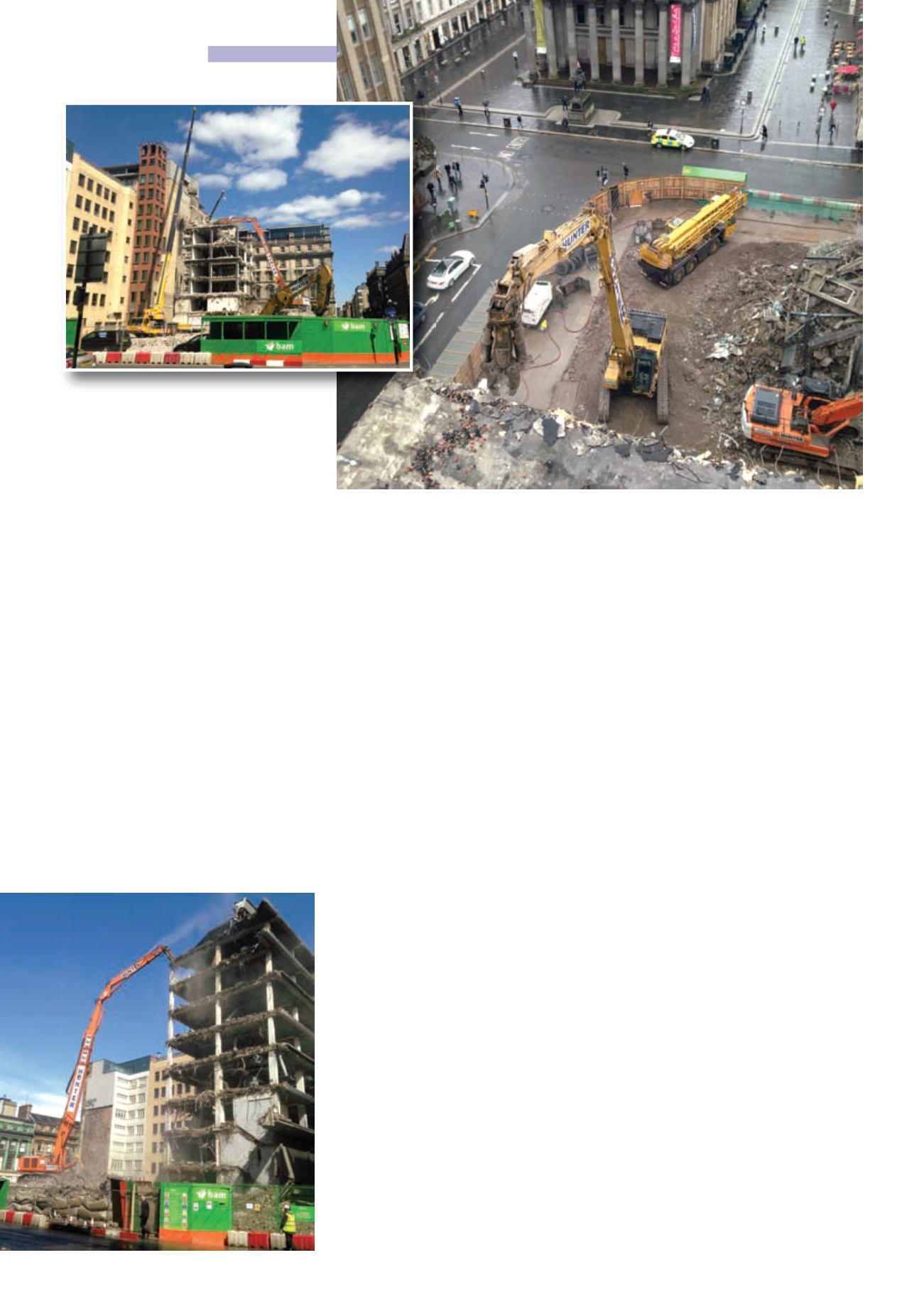
36
CONSTRUCTION EUROPE
DECEMBER 2013-JANUARY 2014
DEMOLITION
>
First, the concrete panels were removed
using cranes, with lifting pins having to be
specially made to incorporate the weight of
the panels, and the angle and location of the
existing lifting holes.
This was a new initiative that relied on
design and reverse engineering in order to
remove the panels in a way that increased
the safety of the operatives involved. They
were removed to plan without any incident.
The removal of these panels was said to be an
entirely new concept.
With the concrete panels removed, Hunter
carried out the safe demolition of the building
using a 40m high reach machine. There was
support from a Cat 345 with an extended
boom to remove the main parts of the
building while leaving the end sections that
tied into the adjoining buildings.
Once down to ground level, the material
from the demolition was then processed on
site and set aside for crushing to 6f2 grade at
a later date.
In total, Hunter removed 2,822.5 tonnes of
6f2, 1.9 tonnes of timber, 5,338.8 tonnes of
concrete and 929.3 tonnes of miscellaneous
scrap – all of which will be processed for
recycling.
The two ends that tied into the neighbouring
properties were then demolished using a
mixture of mechanical and hand demolition,
as a 250mm cavity was found between the
buildings during the original investigation
works.
EVENINGS AND SUNDAYS
Because of the location and the close
proximity of pedestrians and vehicles, Hunter
carried out some of the demolition works
during the evenings and on Sundays.
This part of the work involved localised
footpath and road closures. It was carried out
working very closely with the local council’s
roads department, local bus companies,
surrounding businesses and residents, to
allow the corner sections that were located
close to the normally live footpaths and roads
to be taken down.
Asbestos removal and internal soft stripping
works had been undertaken by others before
the demolition work started. However, once
work was underway and Hunter was three
weeks into the programme, asbestos was
discovered.
Work within this area stopped immediately
until testing could be carried out. While this
testing was being undertaken, and rather
than stop work completely, the methodology
was changed in agreement with the client.
The team moved to another area to start
demolition there, which allowed the
contractor to stay within programme.
With the above ground demolition complete,
Hunter started to remove the material from
within the basement, and to break out the
basement walls and the walls to the vaults.
Crushing of demolition rubble started and,
while this was ongoing, removing the pile
caps began.
With all the basement removal works
complete Hunter Demolition backfilled and
compacted 6f2 material in 300mm layers up
to the existing ground level ready for piling
works by the client to begin.
Customer care was a large factor in this
project and complaints of varying types
arrived daily.The Chair of the Local Community
Group, who was acting as spokesperson for
the Community, delivered a few complaints
that were handled immediately. He also
delivered a number of compliments regarding
“the site management being spot on” and the
appearance on the site.
The site was also visited by Glasgow City
Council’s Environmental Health Department
on a few occasions.
To ensure there was no danger or impact
to surrounding buildings, movement and
vibration monitoring was ongoing in a
number of buildings around the site.
This helped to alleviate concerns from
various businesses and residents who were
concerned about possible impact on the
stability of their building. The monitoring
levels were always below the British standard,
and as a goodwill gesture to these businesses
and residents, Hunter introduced a quiet hour
each day to allow them to conduct sensitive
business, and this proved to be a success.
The site was also under the Considerate
Contractors Scheme and was visited by an
auditor to conduct an assessment. The site
scored 42 out of 50 (the first for a BAM site)
and special recognition was given to the dust
suppression system that was in force.
Gordon Topham, Considerate Contractors
Scheme Auditor, said, “The introduction of a
snow-making machine adapted to project an
atomised water mist over the full demolition
area trapped any dust created by the works
and brought it effectively to the ground.
He added, “If this system was adopted on all
demolition sites, a considerable improvement
would be seen across the industry in the air
quality on demolition sites.”
ce
The highly constrained nature of the city
centre site meant meticulous planning
Dust suppression on the site is crucial
– here both a cannon and the machine
itself are ensuring the minimum of dust is
generated by the demolition work


